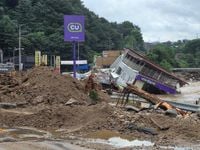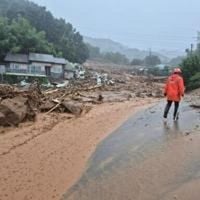South Korea has been grappling with the devastating aftermath of torrential rains that began on July 16, 2025, leaving a trail of destruction, death, and displacement across the country. Over the course of five days, relentless downpours triggered landslides, flash floods, and widespread damage, resulting in at least 14 confirmed deaths and 12 people reported missing, according to government officials and multiple news agencies.
The disaster's impact has been felt most acutely in the southern and central regions of the country, with the southern county of Sancheong bearing the brunt of the catastrophe. This rural area, home to approximately 33,000 residents, recorded nearly 800 millimeters (31.5 inches) of rain since the deluge began on Wednesday, July 16. The volume of water unleashed by the skies overwhelmed local infrastructure and natural barriers, causing landslides and the collapse of homes.
On July 19, rescue teams found eight bodies in Sancheong, with six others still missing. Two more bodies were discovered during search and rescue operations early on July 20, raising the death toll in the county to eight. The adjacent counties of Hapcheon and Hadong also suffered heavy rainfall, receiving 699 millimeters (27.5 inches) and 621.5 millimeters (24.5 inches) respectively, exacerbating the regional crisis.
While Sancheong faced the most severe losses, the resort town of Gapyeong in Gyeonggi province, located about 70 kilometers (40 miles) east of Seoul, witnessed its own tragedy on Sunday, July 20. Early that morning, a landslide engulfed several houses, and floodwaters swept away vehicles, resulting in two deaths and four people reported missing. A woman in her 70s was killed when her house collapsed under the landslide, and the body of a man in his 40s was found near a bridge after drowning in the swollen streams.
Gapyeong recorded close to 170 millimeters (6.7 inches) of rain in a short period, underscoring the intensity of the storm as it moved northward from the southern parts of the country. The Interior and Safety Ministry reported that six people remain missing in Gapyeong and the southern city of Gwangju, where two of the missing persons were last seen. Earlier in the week, three people tragically drowned in a submerged car, and another individual was killed when a retaining wall collapsed onto their vehicle in Osan, just south of Seoul.
As of 9 a.m. on July 20, approximately 3,840 people remained evacuated from their homes, seeking shelter from the floods and landslides. In total, 12,921 people have taken refuge across 14 major cities and provinces, highlighting the widespread displacement caused by the disaster. Authorities have registered 1,920 cases of flooded roads, soil loss, and destroyed public facilities, alongside 2,234 incidents of damage to private property, including buildings and farmland.
Thankfully, the relentless rain that had battered the nation for nearly a week began to subside on Sunday, with heavy rain alerts lifted across most regions. The Korea Meteorological Administration forecasted that the rain would cease entirely on Sunday, to be followed by a heatwave, signaling a dramatic shift in weather patterns. This pause offers a crucial window for rescue and recovery efforts, though the scars left by the storm will take much longer to heal.
South Korea typically experiences monsoon rains in July and is usually well-prepared for such seasonal weather. However, this year's downpours were especially intense, with some of the heaviest hourly rainfall on record. Scientists have pointed to climate change as a key factor driving the increased frequency and severity of extreme weather events worldwide, including in South Korea. The nation has already endured record-breaking rains and flooding in 2022, which resulted in at least 11 fatalities.
The government and emergency services have been working around the clock to manage the crisis. The Interior and Safety Ministry provided regular updates on casualties, missing persons, and evacuations, emphasizing the ongoing risks posed by unstable terrain and swollen rivers. Rescue teams continue to search for those unaccounted for, while efforts to repair damaged infrastructure and restore essential services are underway.
Residents and officials alike face the daunting task of rebuilding communities shattered by the floods. The human toll is stark: families mourning lost loved ones, displaced individuals seeking temporary shelter, and farmers confronting ruined crops and devastated land. The economic impact is expected to be significant, with both public and private properties suffering extensive damage.
Experts warn that as climate change intensifies, such extreme weather events may become more common in the region, necessitating enhanced preparedness and resilience measures. The 2025 floods serve as a sobering reminder of the vulnerabilities that communities face and the urgent need for comprehensive strategies to mitigate future disasters.
For now, South Korea braces itself for the aftermath of this unprecedented weather event, hoping that the respite from rain will bring relief and allow recovery efforts to gain momentum. The coming days will be critical in determining how quickly the nation can heal and rebuild in the face of nature's fury.


